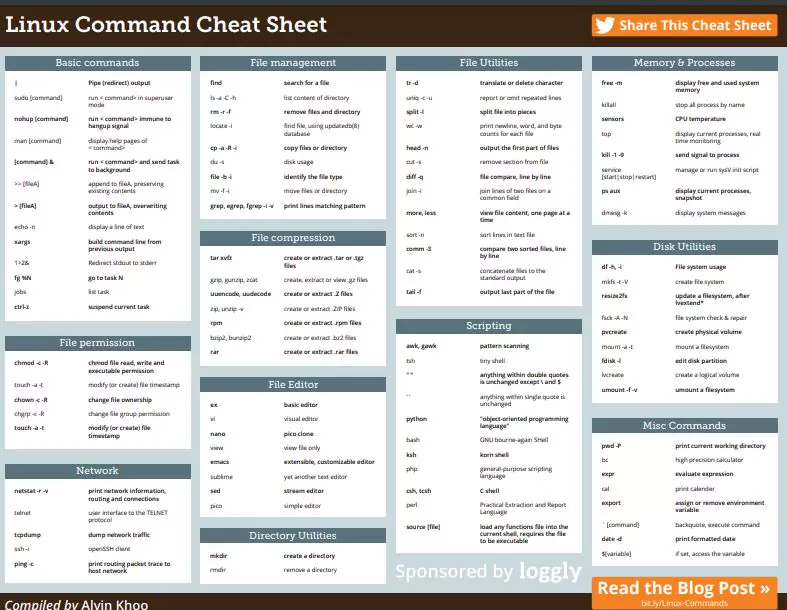‘Linux Commands Cheat Sheet’ PDF Quick download link is given at the bottom of this article. You can see the PDF demo, size of the PDF, page numbers, and direct download Free PDF of ‘Linux Commands Cheat Sheet’ using the download button.
The Linux operating system offers a multitude of commands, which can be overwhelming for beginners.
This cheat sheet helps you get familiar with over 30 basic Linux command-line executables frequently used by developers.
You’ll find easy-to-learn shortcuts and code examples to help you find your way around the Linux command line.
Command Description lsLists all files and directories in the present working directory ls -RLists files in sub-directories as well ls -aLists hidden files as well ls -alNavigate to the HOME directory cd or cd ~Navigate to HOME directory cd ..Move one level up cdTo change to a particular directory cd /Move to the root directory cat > filenameCreates a new file cat filenameDisplays the file content cat file1 file2 > file3Joins two files (file1, file2) and stores the output in a new file (file3) mv file "new file path"Moves the files to the new location mv filename new_file_nameRenames the file to a new filename sudoAllows regular users to run programs with the security privileges of the superuser or root rm filenameDeletes a file manGives help information on a command historyGives a list of all past commands typed in the current terminal session clearClears the terminal mkdir directorynameLists files and directories with detailed information like permissions, size, owner, etc. rmdirDeletes a directory mvRenames a directory pr -xDivides the file into x columns pr -hAssigns a header to the file pr -nDenotes the file with Line Numbers lp -nc , lpr cPrints “c” copies of the File lp-d lp-PCreates a new directory in the present working directory or an at the specified path apt-getSpecifies the name of the printer mail -s 'subject'-b 'bcc-address'Command to send email mail -s "Subject"The command used to install and update packages
Command Description ls -lto show file type and access permission rread permission wwrite permission xexecute permission -=no permission Chown userFor changing the ownership of a file/directory Chown user:group filenamechange the user as well as group for a file or directory
Command Description echo $VARIABLETo display value of a variable envDisplays all environment variables VARIABLE_NAME= variable_valueCreate a new variable UnsetRemove a variable export Variable=valueTo display the value of a variable
Command Description sudo adduser usernameTo add a new user sudo passwd -l 'username'To change the password of a user sudo userdel -r 'username'To remove a newly created user sudo usermod -a -G GROUPNAME USERNAMETo add a user to a group sudo deluser USER GROUPNAMETo remove a user from a group fingerShows information of all the users logged in finger usernameGives information of a particular user
Command Description SSH username@ip-address or hostnamelogin into a remote Linux machine using SSH Ping hostname="" or =""change the directory to “dirname” on a remote computer dirDisplay files in the current directory of a remote computer cd "dirname"upload ‘file’ from local to a remote computer put fileDownload the ‘file’ from the remote to the local computer get fileupload ‘file’ from a local to a remote computer quitLogout
Command Description bgTo send a process to the background fgTo run a stopped process in the foreground topDetails on all Active Processes psGive the status of processes running for a user ps PIDGives the status of a particular process pidofGives the Process ID (PID) of a process kill PIDKills a process niceStarts a process with a given priority reniceChanges priority of an already running process dfGives free hard disk space on your system freeGives free RAM on your system
Command Description iInsert at cursor (goes into insert mode) aWrite after cursor (goes into insert mode) AWrite after the cursor (goes into insert mode) ESCTerminate insert mode uUndo last change UUndo all changes to the entire line oOpen a new line (goes into insert mode) ddDelete line 3ddDelete 3 lines DDelete the contents of the line after the cursor CWrite at the end of the line (goes into insert mode) dwDelete word 4dwDelete 4 words cwChange word xDelete character at the cursor rReplace character ROverwrite characters from cursor onward sSubstitute one character under cursor continue to insert SSubstitute entire line and begin to insert at the beginning of the line ~Change case of individual character
Language English No. of Pages 1 PDF Size 0.94 MB Category Education Source/Credits www.loggly.com
Related PDFs
MS Word Online Test PDF
Linux Tutorial For Beginners PDF
Linux Commands Cheat Sheet PDF Free Download
